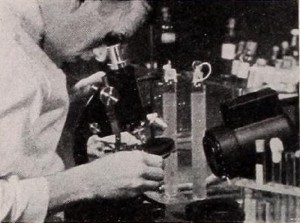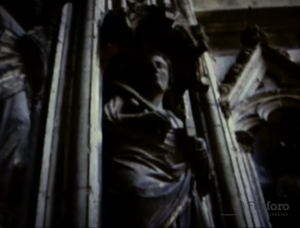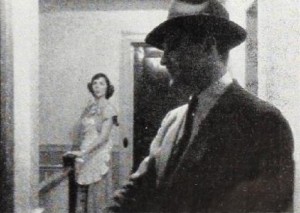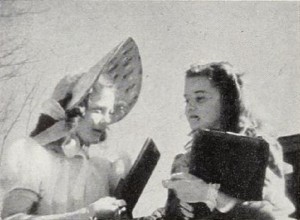Scientific documentary
Symbiosis and protective systems of decapods
È un film scientifico che nella cornice di visioni di suggestiva bellezza, dei fondi marini, tratta dei sistemi di protezione e delle simbiosi di alcuni decapodi. È il primo film scientifico a passo ridotto che sia stato finora realizzato su questo argomento.
Questo film è stato realizzato nella Stazione Zoologica di Napoli, in tre mesi di assiduo lavoro e con ore ed ore di paziente attesa, subordinata alla capricciosa volontà di questi interessantissimi attori.
This is a scientific film that, within the frame of visions of suggestive beauty, of the depths of the sea, deals with the systems of protection and with the symbiosis of some decapods. It is the first scientific small-gauge film that has been made on this subject until now.
This film was made in the Zoological Station of Naples, in three months of assiduous work and with hours and hours of patient waiting, subordinated to the capricious will of these interesting actors.
—Notizario delle sezioni cinematografiche dei gruppi universitari fascisti a cura del ministero della cultura popolare, September 1938 p. 11

"An achieved simplicity in presenting a complex idea is the outstanding accomplishment that wins for the National Oil Products Company an honorable mention for its film. This picture presents the necessity for Vitamin "D" in the food of children and gives the highlights of preparing the Nopco product containing this essential food element. This picture, directed by Ralph Wechsler and photographed by Arnold M. Hill, ACL, follows the safely conventional presentation of industrial film messages in its continuity methods, its use of animated diagrams and its description of ultimate consumer usage. Working within this pattern, the makers of the picture have done extraordinarily well whatever they attempted. The continuity flows so smoothly as to be unperceived unless by a critically inclined observer; the animated diagrams are clear, well executed and strictly limited to the bare necessities of making the idea entirely evident; the photography is unexceptionable in nearly one hundred per cent of the film. This product of the joint efforts of an intelligent director, a very capable cinematographer and a fully cooperating industrial concern shows how perfect a practical film may be if real care is devoted to its making." Movie Makers, Dec. 1933, 522-523.

El filme utiliza rimas y música para describir la arquitectura gótica de Vitoria, capital de Álva en España.
The film describes through rhymes and music the gothic architecture of Vitoria, capital of Álava in Spain.
"documentario/documentary"
"inteso a porre in luce lo sforzo fisico e la passione dei vogatori nel loro formarsi e al giorno della loro prima affermazione"
"intended to highlight the physical effort and passion of the rowers in their training and on the day of their first statement"".—""I Littoriali del cinema: Un’altra interessante serie di documentari,” La Stampa, September 3, 1939

"'The Voice of the Key' is a magnificently staged photoplay, beginning with the very professional series of opening titles and featuring remarkable interior photography, considering the limited equipment at the disposal of the filmer. Charles Carbonaro, using photo-floods entirely, has achieved some truly professional illumination in his interior settings, and his camera technique displays an artist's genuine feel for forceful and dramatic story telling with a camera. The story concerns a murder of an unfaithful wife's lover by her husband, and the steps the husband takes to conceal his part in the crime, only to be tripped up by his door key as the incriminating evidence. Carbonaro used a Cine Special Camera and Eastman Super X panchromatic film. The script, which he wrote himself, was adapted from a story published in 'This Week', Sunday supplement magazine of national distribution." American Cinematographer, Apr. 1950, 133.
"Great ambition and a wide knowledge of both amateur and Hollywood camera techniques mark Charles J. Carbonaro's The Voice of the Key. The film is a whodunit, involving many of the human reactions — from love and hate to cynicism, impatience and sudden passion — all of which have to be registered by the actors at Mr. Carbonaro's command. It's a large order, and the film does not quite fill it dramatically. But the good things about The Voice of the Key are very good indeed." Movie Makers, Dec. 1950, 468.
Documentario/Documentary

"The 246 year old Voorlezer House, believed to be the oldest elementary school building still standing in the United States, is located on Staten Island, N. Y. It has long been an interesting landmark, but it is now preserved for posterity in Kodachrome by the master hand of Frank E. Gunnell. On the occasion of the one hundredth anniversary of New York City's present school system, this site was selected for one part of the ceremonies, and eighteen girls and boys, in costumes designed from illustrations in Godey's Lady's Book, went through a typical day, recreated to appear as it might have been in 1842. Mr. Gunnell's technically superb nature films are well known, but in The Voorlezer's House there is much more than immaculate cinematography. There is lighting that fits the mood of days gone by, and there is a sensitive faculty in the direction of a group of children that is appealing. The film is simple in that the continuity is chronological, but the charm of the Gunnell touch was never more telling than in this picture. If ever a potentially dull film subject was made to glow and come alive, this is the time." Movie Makers, Dec. 1942, 506.
"Playful family montage by the experimental filmmaker who headed the USC School of Cinematic Arts from 1949 to 1951" centerforhomemovies.org
"doc. scientifico"
Total Pages: 299